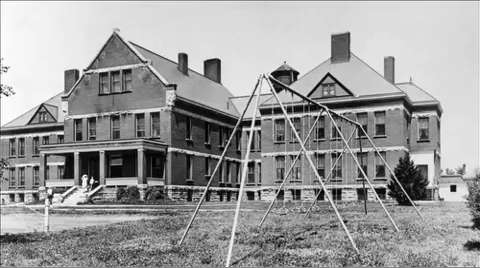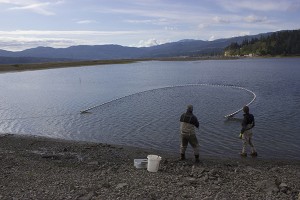By Richard Walker, Indian Country Today Media Network
Love was the common thread in everything Fran James did, whether serving her faith, hosting an unexpected guest, passing on a teaching, or weaving a basket, hat, robe or shawl.
She loved God and worshipped regularly at St. Joachim’s Church, where her passing was mourned May 2. She loved her Coast Salish culture, and taught countless others how to weave using cedar fiber, bear grass, or mountain goat wool. She shared her life and knowledge with everyone and taught all that wanted to learn, family members said. And she loved the company of others; her home was constantly abuzz with visitors.
“You have to ask why she always had so many people around her, what’s the magic,” said Darrell Hillaire, former chairman of the Lummi Nation. “The magic was ordinary love.”
Her view of how to live was simple: Love God. Love others. Don’t gossip. Keep your hands busy. Do your best.
“Her passing has left a void. The fabric that joins us together has weakened,” said Richard Jefferson, a nephew. “But because of all who learned from her, the fabric will grow strong again.”
James, who was known by her Lummi name, Che top ie, and by most people as Auntie Fran, walked on April 28 after surgery for a blocked artery. She was 88.
On May 2, a procession escorted her body six miles from Moles Funeral Home in Ferndale, Washington to St. Joachim’s Church on the Lummi reservation. Pallbearers carried her coffin up the flower-lined steps of the 1861 church, led by drummers and singers. Overflow seating was provided outside, with the funeral Mass shown on two screens.
After Mass, the funeral moved on to the Lummi Nation Cemetery. One by one, mourners dropped handfuls of dirt into the grave and offered hugs and words of comfort to the family. There was a mix of Native songs and Christian hymns, a melding of her faith and her culture. A priest said James had long prayed for the canonization of Kateri Tekakwitha, saying, “She was not only a devout Catholic, she was a devout Native American and wanted to see those two things together.”
The family hosted lunch at the Wexliem Community Building. Love offerings were made to the family, and the family gave gifts to all guests; among the gifts were art prints, beaded necklaces, and bundles of James’s fabric tied with a strand of spun wool—a reference to James’s favorite saying, “Weaving together the fabric of our lives.”
She was born Frances Gladys Lane on May 20, 1925 on Portage Island, Washington. She was raised by her grandmother there, where they raised 500 head of sheep. Her grandmother knitted and sold socks for about 25 cents a pair. Fran learned to spin and knit from her grandmother at the age of 9. She also learned to gather traditional materials and became a master weaver. Her work included twill-plaited cedar and cherry fiber bags; cedar and bear grass baskets of all shapes and uses; cedar hats; split and braided mats of cattail or cedar; elegant blankets and robes of handspun, twill-woven mountain goat or sheep wool.
She taught basketry and weaving at Northwest Indian College. She was a guest artist and instructor until her passing; events and venues included the annual Gathering of Native Artists at the Skagit County Historical Museum, the Northwest Native American Basketweavers Association, and the Burke Museum of Natural History and Culture, which houses a collection of her work. Her work is shown in major Northwest galleries, among them Stonington Gallery in Seattle and Arctic Raven Gallery in the San Juan Islands.
Today, James and her son, Bill—a well-known artist and hereditary chief of the Lummi Nation—are credited with reviving and continuing the traditional weaving skills of the Lummi people. In 1990, the Washington State Historical Society presented Fran and Bill James with the Peace and Freedom Award for “[advancing] public understanding of the cultural diversity of the peoples of Washington state.” In 2002, Fran James was inducted into the Northwest Women’s Hall of Fame as “a nationally recognized Native American artist.”
Theresa Parker, Makah/Lummi, a niece, told of learning how to weave from her Aunt Fran.
“I used to love watching her weave with wool,” Parker said. “I told her, ‘We only have two or three wool weavers down here [at Makah]. That’s something we’re lacking.’ She said, ‘You can come up here anytime.’ ”
During one visit, James had acquired wool from 28 shears, each weighing 5 to 8 pounds. “We washed the wool and laid it out to dry in the back yard. It was such a sight, I’ll never forget that,” Parker said.
One of the sheep that had been sheared was named Henry; he was considered spoiled because his owner allowed him to wander wherever he pleased. As a result, his wool often had burrs that had to be removed.
Midway into removing the troublesome burrs, James told her niece, “Whenever you’re having a rough day, just remember Henry and you’ll get through it.”
In his eulogy at St. Joachim’s Church, Jefferson said his aunt’s work ethic made an indelible impression. He told of a time he and his sons took a load of wood to Aunt Fran’s home. She pointed to the place where she wanted it unloaded, and told them she’d stack it later.
“I was amazed. She was in her 80s then, but that’s how she was,” he said. “She wasn’t afraid of hard work. She was strong, confident and proud.”
Amid that indefatigable energy was humility. The Rev. Khanh Nguyen, pastor of St. Joachim’s Church, said James “put a lot of time and energy into the church. But she didn’t tell you about it. She never said, ‘I did this.’ ”
Throughout the day, people shared with each other what they learned from Aunt Fran, how her legacy will live on through those who follow her example and teachings.
Hillaire said James was not one for idle time or gossip. She only had good things to say about others, and would always end a thought about someone else with “God bless their heart.”
“Her legacy will live on through us and the lives we lead,” she said.
Addressing the vast crowd that gathered graveside to honor his aunt, Jefferson spoke of the importance of spending time and sharing love with others, as his Aunt Fran did. “Don’t let them be alone, go share a meal with them,” he said. “You have those teachings. Follow through.”
Fran James is survived by her son; sisters, Ernestine Gensaw, Rena Ballew, and Beverly Cagey; and numerous nieces and nephews. Her memorial program said she was also “culturally survived by many sons, daughters, nieces, nephews, grandkids, and great-grandkids.”
Read more at http://indiancountrytodaymedianetwork.com/2013/05/06/lummi-master-weaver-fran-james-walks-149230













